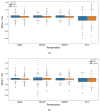Detection of Gait Events Using Ear-Worn IMUs During Functional Movement Tasks
- PMID: 40573516
- PMCID: PMC12196958
- DOI: 10.3390/s25123629
Detection of Gait Events Using Ear-Worn IMUs During Functional Movement Tasks
Abstract
Complex walking tasks such as turning or walking with head movements are frequently used to assess dysfunction in an individual's vestibular, nervous and musculoskeletal systems. Compared to other methods, wearable inertial measurement units (IMUs) allow quantitative analysis of these tasks in less restricted settings, allowing for a more scalable clinical measurement tool with better ecological validity. This study investigates the use of ear-worn IMUs to identify gait events during complex walking tasks, having collected data on 68 participants with a diverse range of ages and movement-related conditions. The performance of an existing gait event detection algorithm was compared with a new one designed to be more robust to lateral head movements. Our analysis suggests that while both algorithms achieve high initial contact sensitivity across all walking tasks, our new algorithm attains higher terminal contact sensitivity for turning and walking with horizontal head turns, resulting in more accurate estimates of stance and swing times. This provides scope to enable more detailed assessment of complex walking tasks during clinical testing and in daily life settings.
Keywords: earables; gait event detection; inertial sensor; temporal parameters.
Conflict of interest statement
The authors declare no conflicts of interest.
Figures








References
-
- Saraf A., Moon S., Madotto A. A survey of datasets, applications, and models for IMU sensor signals; Proceedings of the 2023 IEEE International Conference on Acoustics, Speech, and Signal Processing Workshops (ICASSPW); Rhodes Island, Greece. 4–10 June 2023; pp. 1–5.
MeSH terms
Grants and funding
LinkOut - more resources
Full Text Sources

